
A daylily, day lily or ditch-lily is a flowering plant in the genus Hemerocallis, a member of the family Asphodelaceae, subfamily Hemerocallidoideae, native to Asia. Despite the common name, it is not taxonomically classified in the lily genus. Gardening enthusiasts and horticulturists have long bred Hemerocallis species for their attractive flowers; a select few species of the genus have edible petals, while some are extremely toxic. Thousands of cultivars have been registered by the American Daylily Society, the only internationally recognized registrant according to the International Code of Nomenclature for Cultivated Plants. The plants are perennial, bulbous plants, whose common name alludes to its flowers, which typically last about a day.

Oxalis is a large genus of flowering plants in the wood-sorrel family Oxalidaceae, comprising over 550 species. The genus occurs throughout most of the world, except for the polar areas; species diversity is particularly rich in tropical Brazil, Mexico, and South Africa.
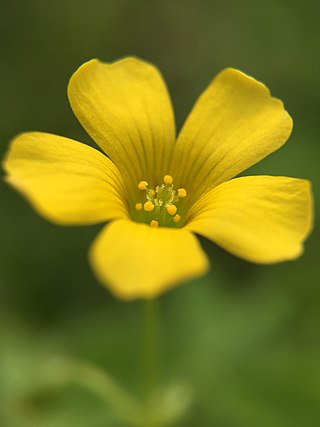
Oxalis corniculata, the creeping woodsorrel, procumbent yellow sorrel or sleeping beauty, is a somewhat delicate-appearing, low-growing herbaceous plant in the family Oxalidaceae.
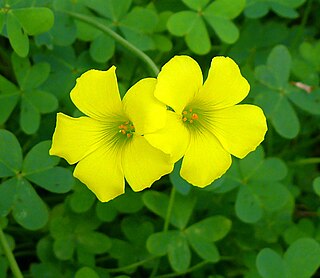
Oxalis pes-caprae is a species of tristylous yellow-flowering plant in the wood sorrel family Oxalidaceae. Oxalis cernua is a less common synonym for this species. Some of the most common names for the plant reference its sour taste owing to oxalic acid present in its tissues. Indigenous to South Africa, the plant has become a pest plant in different parts of the world that is difficult to eradicate because of how it propagates through underground bulbs.
Oxalis ecuadorensis is a species of plant in the family Oxalidaceae. It is endemic to Ecuador.

Oxalis stricta, called the common yellow woodsorrel, common yellow oxalis, upright yellow-sorrel, lemon clover, or more ambiguously and informally "sourgrass", "juicy fruit","sheep weed", or "pickle plant", is a herbaceous plant native to North America and East Asia and has been introduced elsewhere, especially in Europe. It tends to grow in woodlands, meadows, and in disturbed areas as both a perennial and annual. Erect when young, this plant later becomes decumbent as it lies down, and branches regularly. It is not to be confused with similar plants in the same genus which are also often referred to as "yellow woodsorrel".
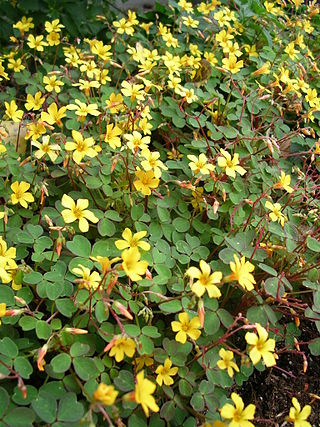
Oxalis spiralis, the spiral sorrel, is a species of plant of the genus Oxalis, a member of the wood sorrel family Oxalidaceae.

Oxalis triangularis, commonly called false shamrock, is a species of perennial plant in the family Oxalidaceae. It is native to several countries in southern South America. This woodsorrel is typically grown as a houseplant but can be grown outside in USDA climate zones 8a–11, preferably in light shade.
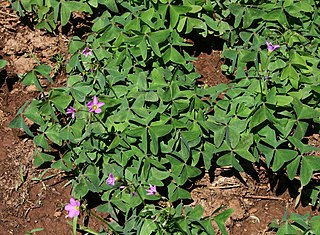
Oxalis latifolia is a species of flowering plant in the woodsorrel family known by the common names garden pink-sorrel and broadleaf woodsorrel. It is native to Mexico and parts of Central and South America. However, it has propagated to other parts of the world.

Swartland Shale Renosterveld is a critically endangered vegetation type of the Western Cape, South Africa.

Limnocharis flava is a species of aquatic flowering plant which is native to Mexico, Central America, South America, Cuba, Haiti and the Dominican Republic but widely naturalized in southern and southeastern Asia: India, Sri Lanka, Cambodia, Burma, Thailand, Vietnam, Indonesia, Malaysia, Brunei and southern China.

Oxalis montana is a species of flowering plant in the family Oxalidaceae known by the common names mountain woodsorrel, wood shamrock, sours and white woodsorrel. It may also be called common woodsorrel, though this name also applies to its close relative, Oxalis acetosella.

Vachellia flava, synonym Acacia ehrenbergiana, is a species of drought-resistant bush or small tree, commonly known as salam in Arabic. It is found in the Sahara, the northern Sahel, parts of East Africa, the Arabian Peninsula and Iran.
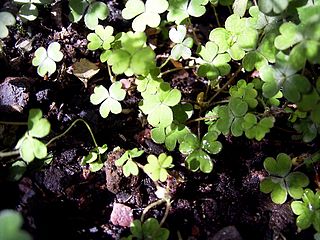
Oxalis magellanica or snowdrop wood-sorrel is an Oxalis species found in Chile, Argentina, New Zealand, and Tasmania. It was first described in 1789. It blooms from fall to spring with white flowers.

Oxalis illinoensis, the Illinois woodsorrel, is a species of flowering plant in the woodsorrel family (Oxalidaceae). It is endemic to the United States, where it found in Illinois, Indiana, Kentucky, and Tennessee. The limits of the range of this species are unclear due to its similarity to Oxalis grandis, with which there has been confusion.

Oxalis dillenii, the southern wood-sorrel, slender yellow woodsorrel, or Dillen's oxalis, is a species in the woodsorrel family. Like other Oxalis species, the leaves of this plant resemble clover leaves, with three leaflets. Oxalis dillenii can be confused with other small yellow flowered species in North America, such as Oxalis florida. The flowers have five yellow petals that are 4 to 10 mm in length. The leaflets are 1 to 2 cm wide with pointed hairs. The fruits are rather brown and are 1.5 to 2.5 cm. It is often considered a weed, and can be found worldwide, but likely originated in North America.

Oxalis virginea, commonly known as Virgin sorrel, is a species from the genus Oxalis. It is endemic to South Africa. O. virginea was first described by Nikolaus Joseph von Jacquin in 1798. This species is apparently lacking a type specimen.
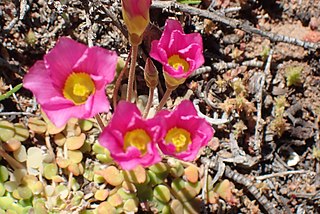
Oxalis inaequalis is a bulb-forming species of flowering plant in the wood sorrel family. It is native to South Africa's Cape Provinces. Each plant produces a rosette of up to 70 succulent leaves, which occasionally produce aerial bulbs. The flowers are yellow and copper-coloured. The sepals are of unequal sizes, hence the specific epithet "inaequalis", which is Latin for "unequal".

Oxalis decaphylla, the ten-leaf woodsorrel, is a species of flowering plant in the family Oxalidaceae. It is native to Arizona, New Mexico, and Mexico, and it has been introduced to Great Britain. A perennial reaching 45 cm (18 in), it is found in a wide variety of damp habitats in otherwise drier areas.




















